15 Best Native Plants for St. Augustine, FL
BY MELANIE JOSEPH | MAY 8TH, 2023 | FLORIDA, LAWN CARE, SAINT AUGUSTINEHomeowners know that finding the perfect plants for landscaping can be tough. But did you know that some of the best options may be right outside your home? St. Augustine’s moderate climate and coastal location make it the ideal habitat for various native plants that thrive in the region.
Choosing native plants for your landscaping not only celebrates the natural beauty of this coastal town but also offers several advantages over non-native species:
- Protects local ecosystems by reducing soil erosion, filtering pollutants from runoff, and maintaining biodiversity
- Supports local wildlife by providing food and habitat for a wide range of pollinators, birds, and other animals
- Better adapted to local conditions, requiring less maintenance, water, fertilizer, and pesticide use
- Lowers long-term costs
Whether you’re looking to enhance your yard’s aesthetic appeal or create a sustainable and eco-friendly landscape, incorporating the best native plants for St. Augustine is a great way to achieve your goals.
In this article, we’ll cover:
- 15 Best Native Plants for Your St. Augustine Yard
- How to Choose Native Plants for Your St. Augustine Landscape
- FAQ About Native St. Augustine Plants
- Where to Find Native Plants in St. Augustine
15 Best Native Plants for Your St. Augustine Yard
Here are 15 of the best native plants for St. Augustine, including trees, shrubs, flowers, and groundcovers.
1. American Beautyberry (Callicarpa Americana)
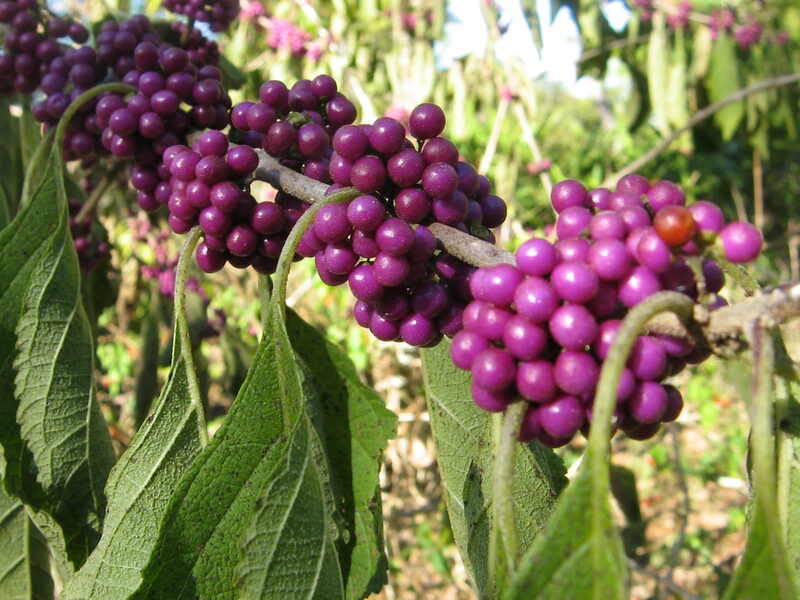
Photo Credit: Korall / Wikimedia Commons / CC BY-SA 3.0
Typically found growing in the understory of wooded areas or along the edges of forests, this deciduous shrub produces small, pinkish-purple flowers in the spring and summer, eventually giving way to clusters of bright, magenta-colored berries in the fall. These berries are a food source for birds, including northern bobwhites and bluebirds.
To make American beautyberry even more beautiful in your garden, consider planting it in groups or mass plantings to showcase its vibrant color. You also can mix it with other native plants, such as Florida anise, swamp milkweed, or goldenrod, to create a diverse and colorful landscape that attracts a variety of pollinators.
While American beautyberry is generally low-maintenance and disease-resistant, it may benefit from regular pruning to encourage a fuller and more attractive shape. If you want to keep the plant looking its best, trim back any dead or diseased branches in late winter or early spring before new growth begins.
Growth habit: Shrub
USDA Hardiness Zone: 6b-11
Mature size: 3-8 feet tall, 4-8 feet wide
Duration: Perennial
Foliage: Deciduous
Sunlight needs: Partial shade to full sun – needs at least four hours of direct sun exposure
Soil preferences: Grows well in most soil conditions but prefers fertile, organic loam soil
Water needs: Low – around 1 inch of water per week, but it needs deep, slow watering during dry spells
Potential hazards: Non-toxic, but its berries may cause discomfort like vomiting if ingested.
2. Beach Sunflower (Helianthus debilis)
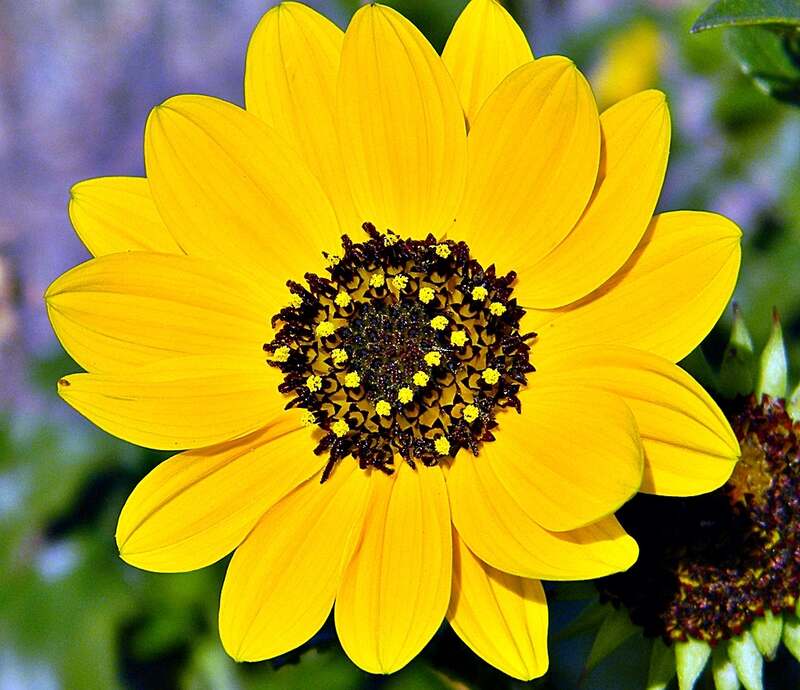
Photo Credit: Bob Peterson / Wikimedia Commons / CC BY-SA 2.0
A beautiful and hardy native plant that thrives in the sandy soils and salty air of St. Augustine’s beaches, this low-growing perennial is a favorite among gardeners in the area for its bright flowers and ability to withstand harsh coastal conditions.
The beach sunflower, which is a member of the aster family, blooms throughout the year, with the peak season occurring in the late summer and fall. During this time, the plant produces a profusion of yellow flowers resembling little suns.
An excellent groundcover, beach sunflower can pair well with other native plants like sea oats and coontie, creating a natural beachy look in your landscape. Deadheading or trimming the flowers can encourage the plant to produce more blooms when the flowers start to fade. But avoid overwatering it if you don’t want it to succumb to sunflower rust.
Growth habit: Flower
USDA Hardiness Zone: 8b-10
Mature size: 2-4 feet tall, 2-4 feet wide
Duration: Perennial
Foliage: Semi-evergreen
Sunlight needs: Full sun, but can tolerate partial shade
Soil preferences: Well-drained, acidic to alkaline, sandy soil
Water needs: Low
Potential hazards: Non-toxic
3. Black-Eyed Susan (Rudbeckia hirta)
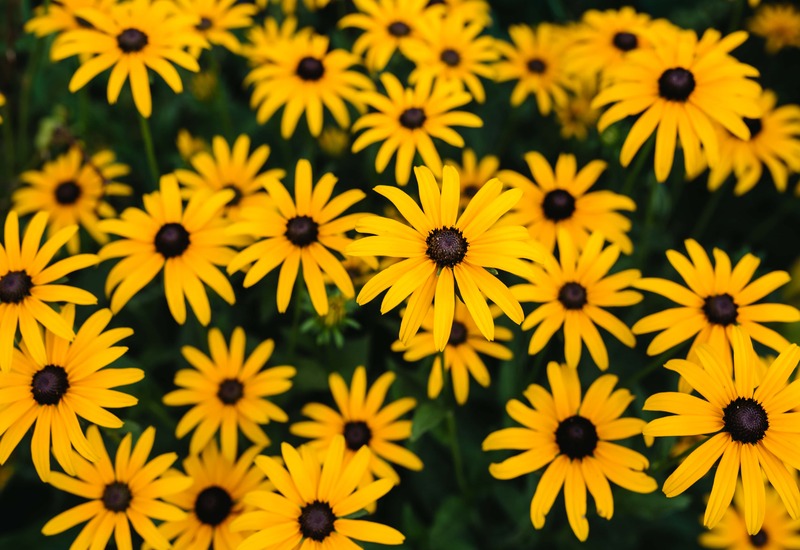
Photo Credit: Pixnio
A showy, resilient wildflower native to much of North America, black-eyed Susan blooms from early summer to fall, producing bright yellow to orange flowers with dark centers. As they are well-suited to the climate and soil conditions of St. Augustine, you’ll often see them planted in parks, public gardens, and along roadsides throughout the city.
In addition to its visual appeal, black-eyed Susan is a valuable food source for pollinators, including butterflies, bees, and hummingbirds. It also provides a habitat for ladybugs and lacewings, which prey on pests like aphids and spider mites.
Deadheading the spent blooms can encourage the plant to produce more flowers, and dividing the clumps every few years can help keep it healthy and vigorous. To make the most of black-eyed Susan in your garden, consider planting it alongside other native perennials, like coneflowers and bee balm.
Growth habit: Wildflower
USDA Hardiness Zone: 3-9
Mature size: 2-4 feet
Duration: Short-lived perennial, annual, or biennial (depending on growing conditions)
Foliage: Deciduous
Sunlight needs: Full sun to partial shade – it needs at least six hours of sun exposure each day
Soil preferences: Well-drained, fertile, acidic, loamy, sandy soil
Water needs: Low
Potential hazards: Non-toxic to humans and pets, but may cause allergic skin reactions and asthma attacks
4. Blanketflower (Gaillardia pulchella)
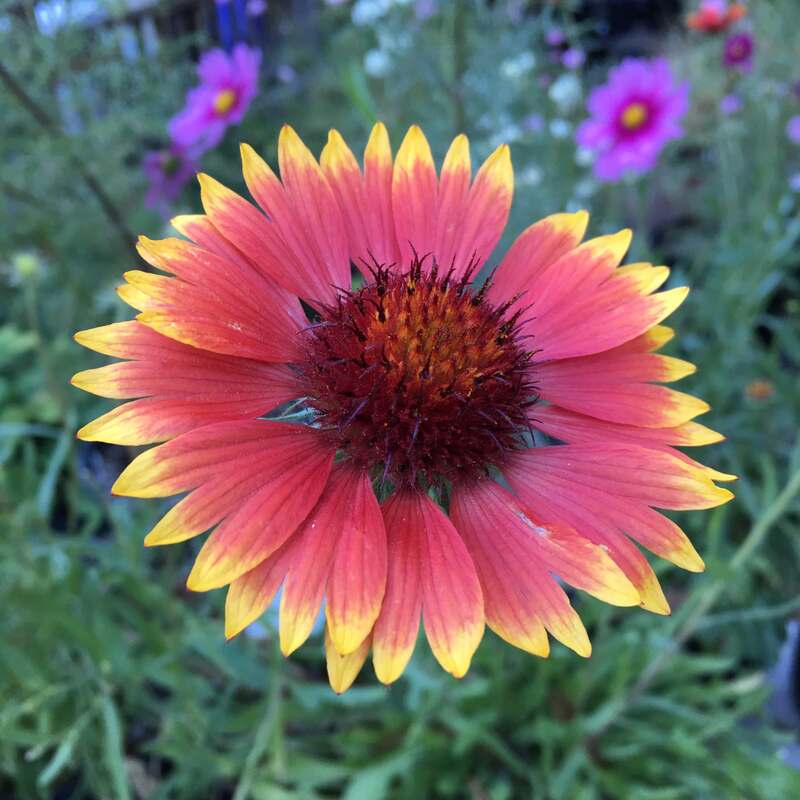
Photo Credit: Macdon / Wikimedia Commons / CC BY-SA 3.0
Another member of the Aster family, blanketflower is popular in pollinator and butterfly gardens, attracting various species with their nectar-rich flowers. You can see them growing in gardens and natural areas, including Anastasia State Park, St. Augustine Beach, and the nearby Guana Tolomato Matanzas National Estuarine Research Reserve.
Native to the prairies of the southern United States, this perennial wildflower thrives in Florida’s sandy soils and warm, humid climate. It typically blooms from late spring through early fall, producing abundant flowers on bushy, compact plants. With its bright red and yellow petals, it can add a splash of color to garden beds, containers, and borders.
Growth habit: Wildflower
USDA Hardiness Zone: 3-10
Mature size: 1-3 feet tall
Duration: Perennial
Foliage: Deciduous
Sunlight needs: Full sun
Soil preferences: Well-drained, dry, acidic, sandy soil
Water needs: Moderate
Potential hazards: Non-toxic, but may cause skin irritation
5. Butterfly Milkweed (Asclepias tuberosa)
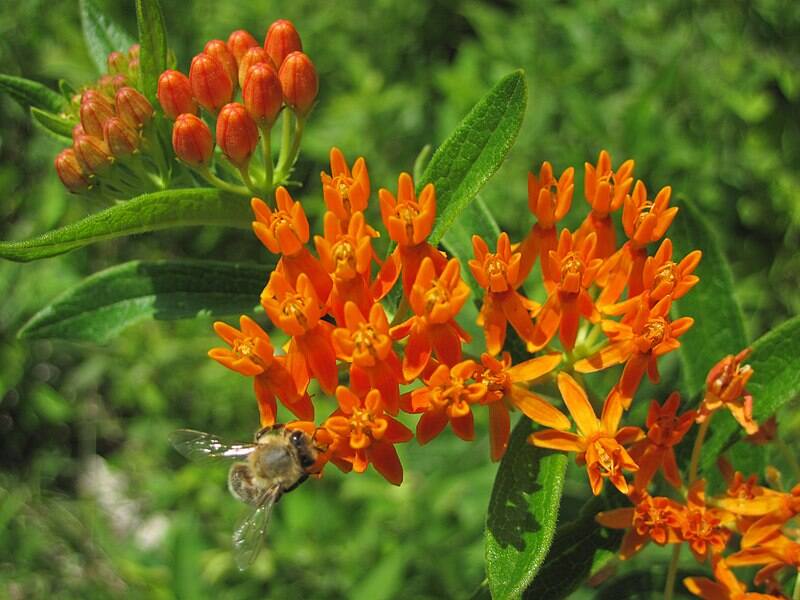
Photo Credit: James St. John / Wikimedia Commons / CC BY 2.0
Blooming from late spring through summer with striking orange flowers, butterfly milkweed stands out in any garden. These flowers not only add a splash of color to any landscape, but they also serve as an important food source for monarch butterflies.
A hardy and beautiful perennial native to Florida, butterfly milkweed grows wild in meadows, fields, and prairies throughout the state. It’s a must-have plant for any homeowner looking to attract pollinators to their garden.
One way to make your butterfly milkweed even more beautiful in the garden is to pair it with other native plants, such as black-eyed Susans, coreopsis, or blanketflowers. To promote healthy growth, water regularly and avoid overfertilizing, as this can lead to weak stems and fewer flowers.
Growth habit: Wildflower
USDA Hardiness Zone: 4-10
Mature size: 1-2 feet tall
Duration: Perennial
Foliage: Deciduous
Sunlight needs: Full sun
Soil preferences: Well-drained, sandy soil
Water needs: Low
Potential hazards: Toxic – every part of the plant is toxic and can be fatal if ingested in large amounts
6. Coontie (Zamia integrifolia)
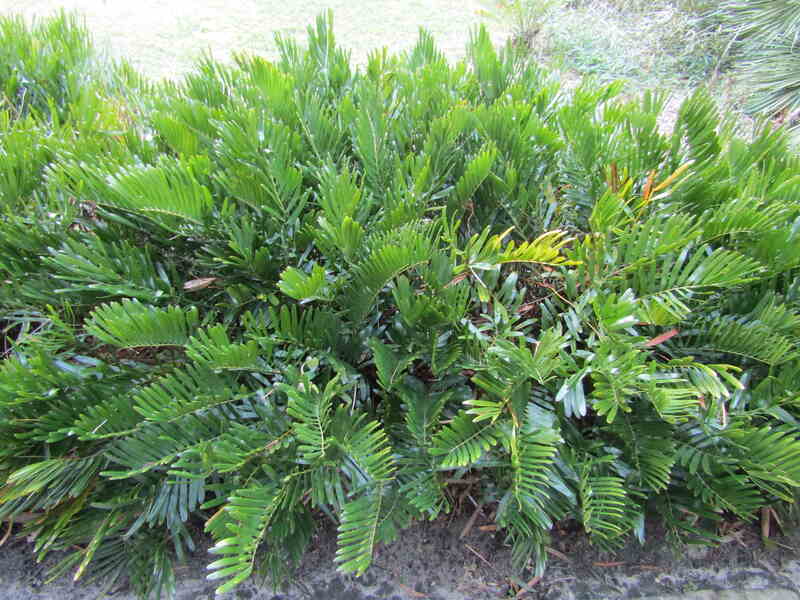
Photo Credit: Leonora (Ellie) Enking / Flickr / CC BY-SA 2.0
Also known as Florida arrowroot, coontie is a slow-growing evergreen indigenous to Florida. It’s well-suited to the area’s warm, humid climate and has a lifespan of over 50 years. It blooms in the spring and produces small, yellowish flowers that are not particularly showy. But its pretty, fern-like foliage and unique texture more than compensate for its inconspicuous blooms.
Coontie is drought-tolerant once established and requires little maintenance, making it an excellent choice for busy homeowners. You can incorporate it into a mixed border with other native species and prune it to keep it in a more compact shape or let it grow naturally to its full size.
The only native cycad in the United States, this ‘living fossil’ has been around for over 200 million years. It’s also the only plant that serves as the larval host for the Atala butterfly – an endangered species native to Florida.
Growth habit: Shrub
USDA Hardiness Zone: 8a-11b
Mature size: 1-3 feet tall, 3-5 feet wide
Duration: Perennial
Foliage: Evergreen
Sunlight needs: Full sun to partial shade (two to six hours of sun per day)
Soil preferences: Well-drained, moist, fertile, sandy soil
Water needs: Low
Potential hazards: Toxic – all parts of the plant are poisonous
7. Coral Honeysuckle (Lonicera sempervirens)
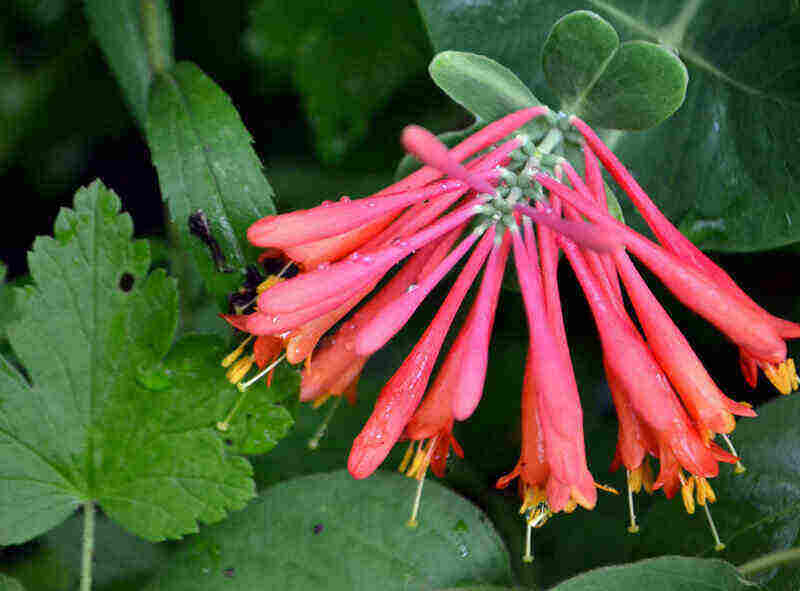
Photo Credit: Jo Naylor / Flickr / CC BY 2.0
Native to Florida and other southeastern states, coral honeysuckle produces bright, coral-red flowers that bloom from spring to fall. Its nectar-rich blooms attract a wide range of pollinators, including hummingbirds, bees, and butterflies, making it a valuable addition to any Florida garden.
This versatile perennial can be planted in various settings, from borders and rock gardens to trellises and fences. It also makes an excellent groundcover, spreading quickly and providing a lush, green carpet of foliage. But remember that it has an extreme flammability rating, so you shouldn’t plant it too close to your house.
To keep your coral honeysuckle looking its best, provide it with plenty of support, such as a trellis or fence. This will encourage it to climb and help prevent it from becoming too leggy or sprawling. To promote new growth and keep it from getting unruly, you also can prune it back in late winter or early spring.
Growth habit: Vine
USDA Hardiness Zone: 4-10
Mature size: 3-20 feet (depending on its supporting structure)
Duration: Perennial
Foliage: Semi-evergreen to evergreen
Sunlight needs: Grows well in partial shade but prefers full sun
Soil preferences: Prefers well-drained, rich, slightly acidic soil but tolerates most soil types
Water needs: Moderate
Potential hazards: Its berries are toxic to humans and pets but favored by birds
8. Ear-Leaved Tickseed (Coreopsis auriculata)
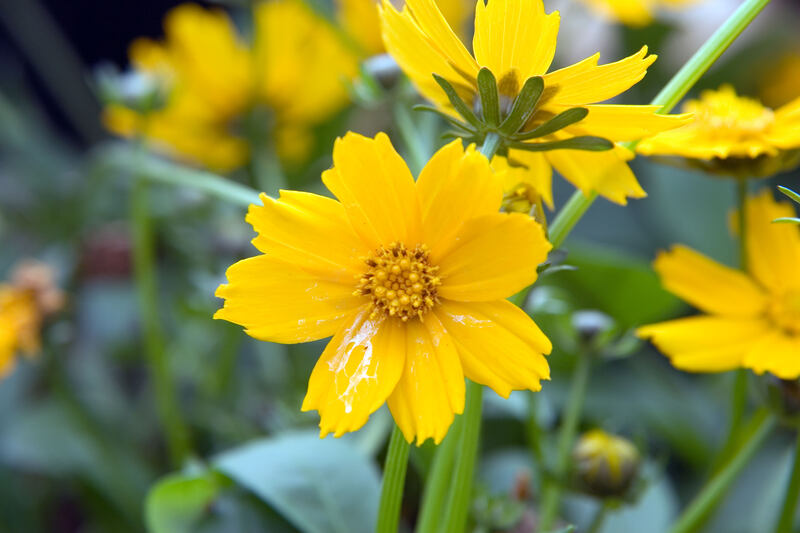
Photo Credit: David J. Stang / Wikimedia Commons / CC BY-SA 3.0
Commonly found growing in the wild in dry, sandy soils in pine forests, sandhills, and open woodlands, ear-leaved tickseed is ideal for planting in large groups, along borders or pathways, or as a groundcover. This plant is a great addition to wildflower gardens or meadow landscapes.
You can plant ear-leaved tickseed in large masses to create a stunning display of yellow blooms. Note that they need regular watering during the first growing season to establish their roots. But once established, they require very little watering, making them ideal for xeriscaping or water-wise gardening.
This perennial plant produces yellow, daisy-like flowers that bloom from spring to summer. It’s a larval host to several butterfly species, including the Florida state butterfly – the zebra longwing. It also attracts a variety of pollinators, including bees and other butterflies.
Growth habit: Wildflower
USDA Hardiness Zone: 4a-9b
Mature size: 1-2 feet tall
Duration: Perennial
Foliage: Deciduous
Sunlight needs: Full sun to partial shade
Soil preferences: Dry, loamy, sandy soil
Water needs: Low
Potential hazards: Non-toxic
9. Florida Anise (Illicium floridanum)
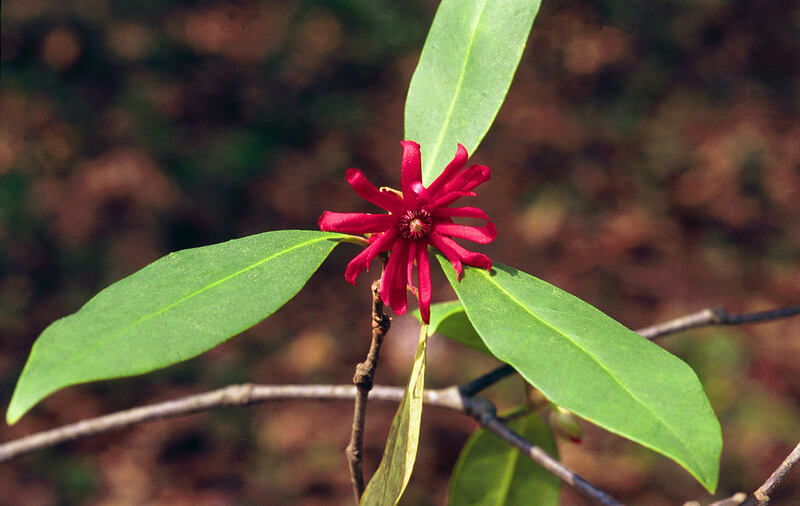
Photo Credit: Ted Bodner / Wikimedia Commons / CC BY 3.0 US
Native to Florida, this evergreen shrub with glossy, dark green leaves grows naturally in moist, shaded areas throughout the state. It’s known for its large, star-shaped fruits that ripen in the fall and are a food source for many bird species.
A larval host plant for the spicebush swallowtail butterfly, Florida anise blooms in the spring, producing clusters of small, maroon flowers that have a sweet, spicy scent.
Remove dead or damaged branches and prune the shrub regularly to maintain its shape. Also, apply mulch around its base to retain moisture during the hot summer months. You also can grow it in containers or use it as a unique accent plant.
Growth habit: Shrub
USDA Hardiness Zone: 8-10
Mature size: 10-15 feet tall, 6-10 feet wide
Duration: Perennial
Foliage: Evergreen
Sunlight needs: Full sun to partial shade
Soil preferences: Moist, well-drained, fertile, clay, loamy, sandy soil
Water needs: Low – while it’s drought-tolerant, you will need to water it weekly during long periods of dry spells
Potential hazards: Toxic to humans and pets
10. Oakleaf Hydrangea (Hydrangea quercifolia)
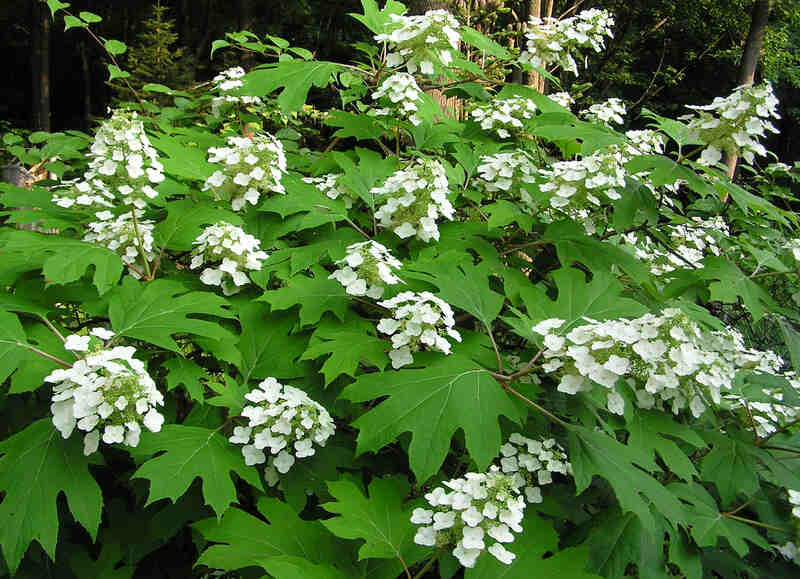
Photo Credit: normanack / Flickr / CC BY 2.0
Known for its large, showy flowers, oakleaf hydrangea blooms in late spring to early summer. The flowers are typically white but can take on pink or red tones in certain soil conditions. As its name suggests, the foliage of this Florida-friendly plant resembles that of an oak tree – with large, lobed leaves that turn a beautiful shade of burgundy in the fall.
Since it’s native to the Southeast U.S., oakleaf hydrangea is already well adapted to the hot and humid climate of St. Augustine. But regular pruning can help keep the plant healthy and encourage more blooms. Also, deadheading spent flowers can help promote new growth and extend the plant’s blooming period.
The oakleaf hydrangea is a great plant for attracting wildlife to your garden. Its large flowers are a favorite of pollinators, including bees and butterflies, while the plant’s foliage provides shelter for birds and other small creatures.
Growth habit: Shrub
USDA Hardiness Zone: 5a-9b
Mature size: 4-8 feet tall
Duration: Perennial
Foliage: Deciduous
Sunlight needs: Full sun to partial shade
Soil preferences: Fertile, loamy, or sandy soil
Water needs: Moderate
Potential hazards: Toxic – every part of this plant is poisonous and must not be ingested by humans and animals
11. Pink Pinxter Azalea (Rhododendron canescens)
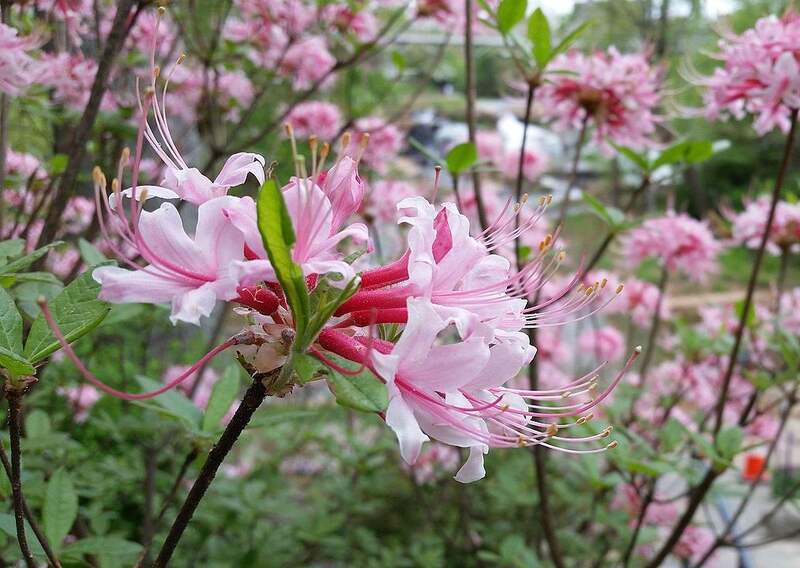
Photo Credit: EoRdE6 / Wikimedia Commons / CC BY-SA 4.0
Native to Florida, pink pinxter azalea grows naturally in wetlands, woodlands, along stream banks, gardens, parks, and natural areas throughout St. Augustine and Jacksonville. It blooms with bright pink flowers in the early spring, serving as an important food source for pollinators like bees, butterflies, and hummingbirds. It’s also a larval host plant for the Eastern tiger swallowtail butterfly.
Consider planting pink pinxter azalea in a shady area with well-draining soil rich in organic matter. The plant requires regular watering, especially during periods of drought. Pruning after flowering can help shape the plant and promote healthy growth.
Growth habit: Shrub
USDA Hardiness Zone: 5-9
Mature size: 6-15 feet tall, 6-10 feet wide
Duration: Perennial
Foliage: Deciduous
Sunlight needs: Partial shade
Soil preferences: Moist to dry, well-drained, acidic soil
Water needs: Moderate
Potential hazards: Highly toxic to both humans and pets
12. Sabal Palm (Sabal jamesiana)
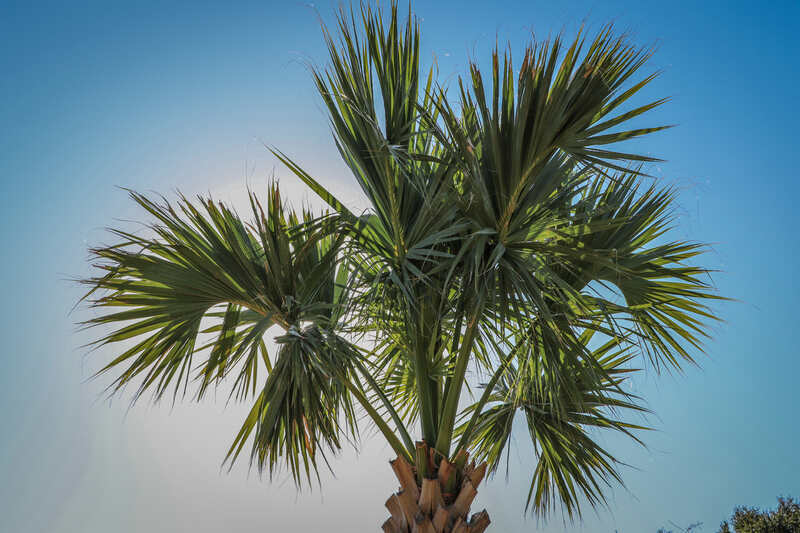
Photo Credit: Pxhere
An iconic symbol of Florida, Sabal palm is the most common palm you’ll see throughout the state. Like saw palmetto, this slow-growing palm also thrives in sandy soils in wetlands, hammocks, and coastal plains. This hardy plant can withstand droughts, saltwater spray, and hurricanes, making it an ideal choice for landscaping in St. Augustine.
Sabal palm blooms in late spring, producing small yellow flowers that attract pollinators such as bees and butterflies. Its fruit, which is dark blue or black when ripe, is a favorite food source for birds such as woodpeckers and bluejays.
Remember to trim the lower leaves of the palm to showcase its unique trunk, which is covered in a brown fibrous material. You also can add mulch around its base to help retain moisture and control weeds.
Growth habit: Tree
USDA Hardiness Zone: 7b-11b
Mature size: 20-30 feet tall, though it can grow up to 90 feet in the woods
Duration: Perennial
Foliage: Evergreen
Sunlight needs: Full sun to partial shade
Soil preferences: Moist, well-drained, loamy, or sandy soil
Water needs: Moderate – but for the first six months, water it often until established
Potential hazards: Toxic to humans and pets – can cause paralysis or even death
13. Scarlet Sage (Salvia coccinea)
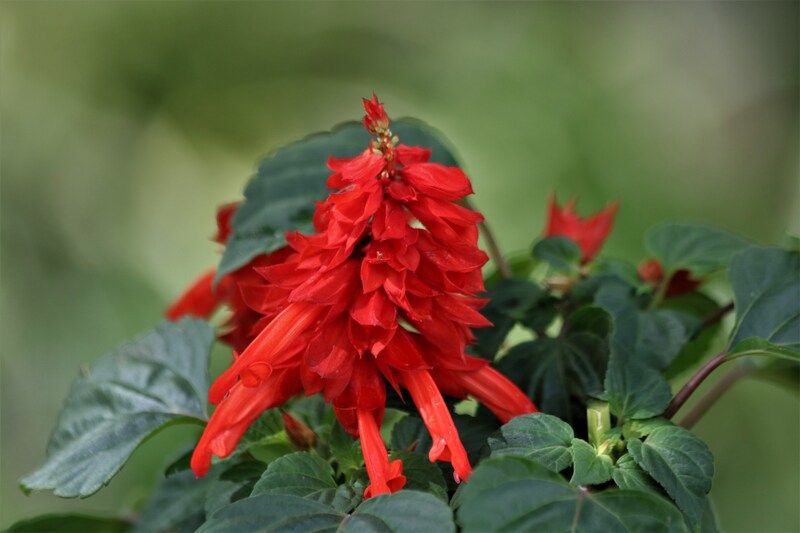
Photo Credit: PublicDomainPictures
Also known as red salvia or scarlet salvia, scarlet sage is a stunning herbaceous perennial plant popularly grown in St. Augustine. This bright red-flowered plant is a showstopper in any garden or landscape, adding beautiful color and texture to any outdoor space. It’s a native of tropical and subtropical regions of the United States, including Florida, and thrives in the warm, humid climate of St. Augustine.
With pungent foliage that makes it deer-resistant, scarlet sage blooms from late spring to early fall, producing vibrant red or pink flowers that attract butterflies and hummingbirds. This evergreen is also a host plant for the white peacock butterfly, providing a source of food and habitat for its larvae.
Scarlet sage reseeds easily but needs regular watering and fertilizing to help it thrive. Also, removing spent flowers can encourage more blooms. You also should prune the plant back after its blooming season to help it grow bushier and produce more flowers the following year.
Growth habit: Wildflower
USDA Hardiness Zone: 8-10
Mature size: 1-3 feet tall
Duration: Perennial – annual in regions with below-freezing winters
Foliage: Evergreen
Sunlight needs: Full sun to shade
Soil preferences: Moist to dry, clay, loamy, or sandy soil
Water needs: Moderate
Potential hazards: Toxic – its flowers can cause gastric distress
14. Southern Live Oak (Quercus virginiana)
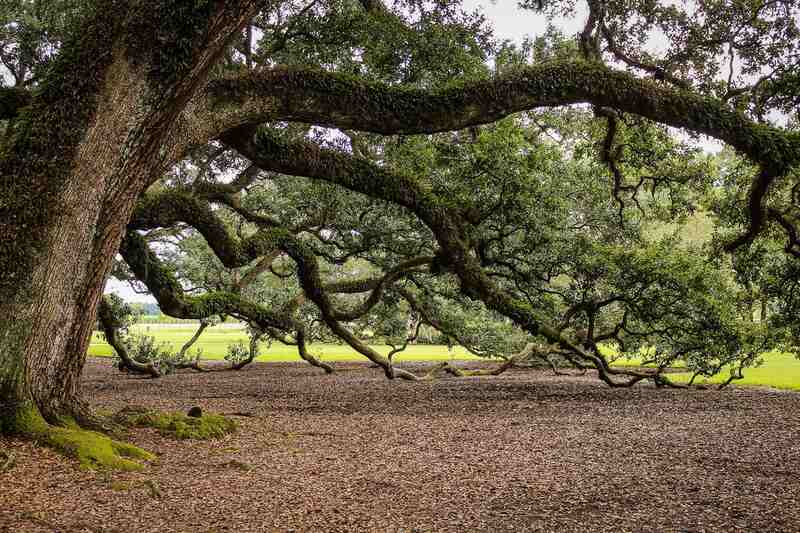
Photo Credit: Pxhere
With their wide-spreading canopies and distinctive twisting branches, Southern live oaks are iconic features of the Florida landscape. You can find them throughout the city’s historic districts, public parks, and private gardens. Since the natural habitat of Southern live oaks is in coastal regions, they are well adapted to the sandy soils, salt spray, and high winds of these environments.
Typically blooming in the spring, these trees produce small, inconspicuous flowers that are pollinated by the wind. These evergreen trees are important host plants for a variety of butterfly and moth species, including the giant swallowtail butterfly and the io moth.
Regular watering and fertilization can help promote healthy growth and ensure the tree remains strong and disease-resistant. Additionally, pruning should be done carefully to maintain the tree’s natural shape and to prevent any damage to the branches or trunk. Also, consider incorporating other native plant species around the base of the tree to create a beautiful and sustainable landscape design.
Growth habit: Tree
USDA Hardiness Zone: 8a-10b
Mature size: 40-80 feet tall, 30-100 feet wide
Duration: Perennial
Foliage: Evergreen
Sunlight needs: Full sun to partial shade
Soil preferences: Moist, well-drained, loamy soil
Water needs: Low
Potential hazards: Toxic – avoid ingesting the acorns and leaves as they can be poisonous to both humans and animals
15. Walter’s Viburnum (Viburnum obovatum)
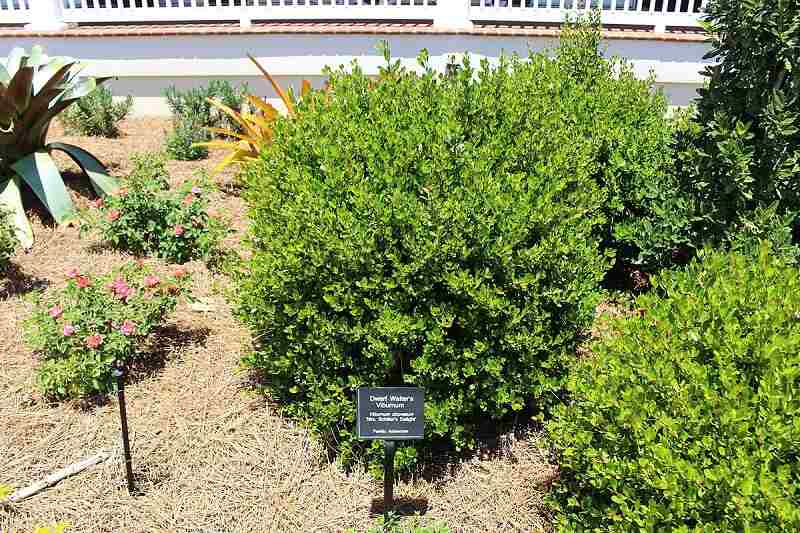
Photo Credit: Michael Rivera / Wikimedia Commons / CC BY-SA 4.0
Walter’s viburnum, also known as sweet viburnum, is a popular shrub for hedges or screens. It produces fragrant, creamy-white flowers in the spring while its glossy, dark green leaves provide year-round appeal. Its flowers are a favorite among pollinators such as butterflies, bees, and hummingbirds while the plant provides cover and nesting sites for birds.
In addition to its ornamental value, Walter’s viburnum also serves as a larval host for the viburnum sphinx moth. This shrub responds well to pruning, and shaping it into a hedge or topiary can create a stunning focal point in any landscape. Applying a slow-release fertilizer in the spring can help promote healthy growth and abundant blooms.
Growth habit: Shrub to small tree
USDA Hardiness Zone: 7-10
Mature size: 8-25 feet tall
Duration: Perennial
Foliage: Evergreen to semi-evergreen in regions with mild winters
Sunlight needs: Partial shade to full sun
Soil preferences: Moist, well-drained, clay, sandy soils
Water needs: Low, but water it often until established (six to 12 months after planting)
Potential hazards: Non-toxic
How to Choose Native Plants for Your St. Augustine Landscape
St. Augustine is home to a diverse range of native plant species, from stunning wildflowers to lush shrubs and trees. With an average low temperature of around 48 degrees Fahrenheit, the city falls primarily into USDA hardiness zone 9a. This zone provides the perfect conditions for many native plants to thrive, but you must choose plants well-suited to your specific yard.
Not only do native plants enhance the beauty of your yard, but they also support the local ecosystem and help maintain the area’s natural balance. But while the region’s well-draining, sandy soil is ideal for many native plants, some may require additional nutrients or amendments to thrive.
Moreover, many native plants are drought-tolerant and can withstand hot, humid summers, but you must consider water usage and conservation. Using mulch and compost can help retain soil moisture and reduce the need for watering.
Before selecting plants, test your soil first. You can get help from your local cooperative extension or soil testing lab to determine your soil’s pH level, texture, and nutrient and salinity levels. This way, you can choose the plants best suited to your soil type.
FAQ About Native St. Augustine Plants
While St. Augustine is known for its lush greenery and subtropical climate, creating a backyard buffer can be an essential step in preserving the natural beauty of the area and protecting your home from hurricanes. Native plants are an excellent choice for this purpose, as they are well-suited to the local climate and can provide food and shelter for local wildlife.
Some of the best native plants for a backyard buffer in St. Augustine include coontie, firebush, muhly grass, red cedar, and wax myrtle.
Apart from beach sunflowers, other plants that bloom year-round in Florida include the Egyptian star cluster, plumbago, and porterweed. But remember that some perennial plants that show flowers all year in South Florida, like firespike, only bloom in certain months in North Florida.
The type of soil found in Northeast Florida can vary depending on location. But since St. Augustine is known for its warm weather, beautiful beaches, and diverse ecosystems, including salt marshes, barrier islands, and coastal forests, the city has mostly sandy soil with low fertility.
The sandy soil here is well-drained and doesn’t retain moisture well, making it challenging for plants to establish deep roots and absorb the nutrients they need to thrive. Adding organic matter, like compost, to sandy soil can help improve soil structure, water-holding capacity, and nutrient content. Still, it’s better to choose native plants well-suited to the local soil conditions as they don’t require excessive watering or fertilization.
Even though St. Augustinegrass is a popular choice for many homeowners in the area, it may not be the best fit for a garden that features a variety of native plants. This is because St. Augustine grass is known to be aggressive and can outcompete other plants for resources.
A better option would be Zoysiagrass. This warm-season grass can thrive in the heat and humidity of St. Augustine and has a slower growth rate than St. Augustinegrass. This means it’s less likely to compete with native plants for resources, allowing them to grow and flourish.
Another option to consider is a ground cover, such as coontie, beach sunflower, creeping phlox, dwarf mondo grass, or creeping thyme. These low-growing plants can provide a green carpet-like appearance without the aggressive growth of St. Augustinegrass. They’re also great for edging walkways or filling in gaps between stepping stones – providing a visual contrast and adding texture to your garden.
Where to Find Native Plants in St. Augustine
St. Augustine is blessed with a rich diversity of native plant species, including flowering perennials, shrubs, and trees that thrive in the area’s unique climate and soil. If you’re looking to add some indigenous flora to your garden, there are several local nurseries and plant resources to check out.
Start your search with the Florida Native Plant Society, a statewide organization that promotes using native plants in landscaping and conservation. Their website provides much information on local plant species, their growing conditions, and where to find them.
When selecting native plants for your garden, consider the environmental conditions of your site, including soil type, water availability, and exposure to sun and shade. Also, purchase plants from reputable sources and avoid transplanting them from the wild.
Adding native plants to your landscape can help create a sustainable and low-maintenance garden that supports local ecosystems and provides habitat for native wildlife.
But if you’re short on time or unsure where to start, consider hiring a St. Augustine landscaping pro to help design and maintain your beautiful, eco-friendly garden.
Main Image Credit: Lazaregagnidze / Wikimedia Commons / CC BY-SA 4.0